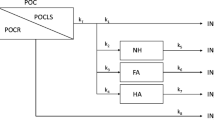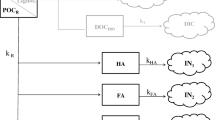Abstract
Background, aim, and scope
Dissolved humic substances (HS) usually comprise 50–80% of the dissolved organic carbon (DOC) in aquatic ecosystems. From a trophic and biogeochemical perspective, HS has been considered to be highly refractory and is supposed to accumulate in the water. The upsurge of the microbial loop paradigm and the studies on HS photo-degradation into labile DOC gave rise to the belief that microbial processing of DOC should sustain aquatic food webs in humic waters. However, this has not been extensively supported by the literature, since most HS and their photo-products are often oxidized by microbes through respiration in most nutrient-poor humic waters. Here, we review basic concepts, classical studies, and recent data on bacterial and photo-degradation of DOC, comparing the rates of these processes in highly humic ecosystems and other aquatic ecosystems.
Materials and methods
We based our review on classical and recent findings from the fields of biogeochemistry and microbial ecology, highlighting some odd results from highly humic Brazilian tropical lagoons, which can reach up to 160 mg C L−1.
Results and discussion
Highly humic tropical lagoons showed proportionally lower bacterial production rates and higher bacterial respiration rates (i.e., lower bacterial growth efficiency) than other lakes. Zooplankton showed similar δ13C to microalgae but not to humic DOC in these highly humic lagoons. Thus, the data reviewed here do not support the microbial loop as an efficient matter transfer pathway in highly humic ecosystems, where it is supposed to play its major role.
In addition, we found that some tropical humic ecosystems presented the highest potential DOC photo-chemical mineralization (PM) rates reported in the literature, exceeding up to threefold the rates reported for temperate humic ecosystems. We propose that these atypically high PM rates are the result of a joint effect of the seasonal dynamics of allochthonous humic DOC input to these ecosystems and the high sunlight incidence throughout the year. The sunlight action on DOC is positive to microbial consumption in these highly humic lagoons, but little support is given to the enhancement of bacterial growth efficiency, since the labile photo-chemical products are mostly respired by microbes in the nutrient-poor humic waters.
Conclusions
HS may be an important source of energy for aquatic bacteria in humic waters, but it is probably not as important as a substrate to bacterial growth and to aquatic food webs, since HS consumption is mostly channeled through microbial respiration. This especially seems to be the case of humic-rich, nutrient-poor ecosystems, where the microbial loop was supposed to play its major role. Highly humic ecosystems also present the highest PM rates reported in the literature. Finally, light and bacteria can cooperate in order to enhance total carbon degradation in highly humic aquatic ecosystems but with limited effects on aquatic food webs.
Recommendations and perspectives
More detailed studies using C- and N-stable isotope techniques and modeling approaches are needed to better understand the actual importance of HS to carbon cycling in highly humic waters.




Similar content being viewed by others
References
Amado AM, Farjalla VF, Esteves FA, Bozelli RL (2003) DOC photo-oxidation in clear water Amazonian aquatic ecosystems. Amazoniana 17:513–523
Amado AM, Farjalla VF, Esteves FA, Bozelli RL, Roland F, Enrich-Prast A (2006) Complementary pathways on dissolved organic carbon removal pathways in clear-water Amazonian ecosystems: photochemical degradation and bacterial uptake. FEMS Microbiol Ecol 56:8–17
Amado AM, Cotner JB, Suhett AL, Esteves FA, Bozelli RL, Farjalla VF (2007) Contrasting interactions mediate dissolved organic matter decomposition in tropical aquatic ecosystems. Aquat Microb Ecol 49:25–34
Anesio AM, Granéli W, Aiken GR, Kieber DJ, Mopper K (2005) Effect of humic substance photodegradation on bacterial growth and respiration in lake water. Appl Environm Microbiol 71:6267–6275
Azam F, Fenchel T, Field JG, Gray JS, Meyer-Reil LA, Thingstad F (1983) The ecological role of water-column microbes in the sea. Mar Ecol Prog Ser 10:257–263
Bertilsson S, Tranvik LJ (2000) Photochemical transformation of dissolved organic matter in lakes. Limnol Oceanogr 45:753–762
Bertilsson S, Stepanauskas R, Cuadros-Hansson R, Granéli W, Wikner J, Tranvik L (1999) Photochemically induced changes in bioavailable carbon and nitrogen pools in a boreal watershed. Aquat Microb Ecol 19:47–56
Cole JJ, Carpenter SR, Pace ML, van de Bogert MC, Kitchell JL, Hodgson JR (2006) Differential support of lake food webs by three types of terrestrial organic carbon. Ecol Lett 9:558–568
Cotner JB, Biddanda BA (2002) Small players, large role: microbial influence on biogeochemical processes in pelagic aquatic ecosystems. Ecosystems 5:105–121
Daniel C, Gutseit K, Anesio AM, Granéli W (2005) Microbial food webs in the dark: independence of lake plankton from recent algal production. Aquat Microb Ecol 38:113–123
Daniel C, Granéli W, Kritzberg ES, Anesio AM (2006) Stimulation of metazooplankton by photochemically modified dissolved organic matter. Limnol Oceanogr 51:101–108
De Haan H (1974) Effect of a fulvic acid fraction on the growth of a Pseudomonas from Tjeukemeer (the Netherlands). Fresh Biol 4:301–310
del Giorgio PA, Cole JJ (1998) Bacterial growth efficiency in natural aquatic ecosystems. Annu Rev Ecol Syst 29:503–514
del Giorgio PA, Davis J (2003) Patterns in dissolved organic matter lability and consumption across aquatic ecosystems. In: Findlay SEG, Sinsabauhg RL (eds) Aquatic Ecosystems: Interactivity of dissolved organic matter. Academic Press, San Diego, CA, pp 399–424
Farjalla VF, Anesio AM, Bertilsson S, Granéli W (2001) Photochemical reactivity of aquatic macrophyte leachates: abiotic transformations and bacterial response. Aquat Microb Ecol 24:187–195
Farjalla VF, Faria BM, Esteves FA (2002) The relationship between DOC and planktonic bacteria in tropical coastal lagoons. Arch Hydrobiol 156:97–119
Farjalla VF, Azevedo DA, Esteves FA, Bozelli RL, Roland F, Enrich-Prast A (2006) Influence of hydrological pulse on bacterial growth and DOC uptake in a clear-water Amazonian lake. Microb Ecol 52:334–344
Farjalla VF, Marinho CC, Faria BM, Amado AM, Esteves FA, Bozelli RL, Giroldo D (2009) Synergy of fresh and accumulated organic matter to bacterial growth. Microb Ecol 57:657–666
Farquhar GD, O’Leary MH, Berry JA (1982) On the relationship between carbon isotope discrimination and the intercellular carbon dioxide concentration in leaves. Aust J Plant Physiol 9:121–137
Fry B (2006) Stable Isotope Ecology. Springer, New York, NY, USA
Granéli W, Lindell M, Tranvik L (1996) Photo-oxidative production of dissolved inorganic carbon in lakes of different humic content. Limnol Oceanogr 41:698–706
Granéli W, Lindell M, Faria BM, Esteves FA (1998) Photoproduction of dissolved inorganic carbon in temperate and tropical lakes—dependence on wavelength band and dissolved organic carbon concentration. Biogeochem 43:175–195
Hollanda-Carvalho P, Sánchez-Botero JI, Pellegrini-Caramaschi E, Bozelli RL (2003) Temporal variation of fish community richness in coastal laggons of Restinga de Jurubatiba National Park, Rio de Janeiro, Brazil. Acta Limnol Bras 15:31–40
Jansson M (1998) Nutrient limitation and bacteria-phytoplankton interactions in humic lakes. In: Hessen DO, Tranvik L (eds) Aquatic Humic Substances–Ecology and Biogeochemistry. Springer-Verlag, Berlin, pp 177–195
Jansson M, Blomqvist P, Jonsson A, Bergström A-K (1996) Nutrient limitation of bacterioplankton, autotrophic and mixotrophic phytoplankton and heterotrophic nanoflagellates in Lake Örträsket, a large humic lake in northern Sweden. Limnol Oceanogr 41:1552–1559
Jansson M, Bergström A-K, Blomqvist P, Drakare S (2000) Allochthonous organic carbon and phytoplankton/bacterioplankton production relationships in lakes. Ecology 81:3250–3255
Jansson M, Berström A-K, Lymer D, Vrede K, Karlsson J (2006) Bacterioplankton growth and nutrient uses efficiency under variable organic carbon and inorganic phosphorus ratios. Microb Ecol 52:358–364
Jonsson A, Meili M, Bergstrom A-K, Jansson M (2001) Whole-lake mineralization of allochthonous and autochthonous organic carbon in a large humic lake (Ortrasket, N. Sweden). Limnol Oceanogr 46:1691–1700
Karlsson J (2007) Different carbon support for respiration and secondary production in unproductive lakes. Oikos 116:1691–1696
Karlsson J, Jonsson A, Jansson M (2001) Bacterioplankton production in lakes along an altitude gradient in the subartic north of Sweden. Microb Ecol 42:372–382
Karlsson J, Jonsson A, Meili M, Jansson M (2003) Control of zooplankton dependence on allochthonous organic carbon in humic and clearwater lakes in northern Sweden. Limnol Oceanogr 48:269–276
Lindell MJ, Granéli W, Tranvik LJ (1995) Enhanced bacterial growth in response to photochemical transformation of dissolved organic matter. Limnol Oceanogr 40:195–199
Lindell MJ, Granéli W, Bertilsson S (2000) Seasonal photoreactivity of dissolved organic matter from lakes with contrasting humic content. Can J Fish Aquat Sci 57:875–885
McKnight DM, Aiken GR (1998) Sources and age of aquatic humus. In: Hessen DO, Tranvik L (eds) Aquatic Humic Substances–Ecology and Biogeochemistry. Springer-Verlag, Berlin, pp 9–39
Mook WG, Bommerson JC, Staverman WH (1974) Carbon isotope fractionations between dissolved bicarbonate and gaseous carbon dioxide. Earth Planet Sci Lett 22:169–176
Moran MA, Covert JS (2003) Photochemical mediated linkages between dissolved organic matter and bacterioplankton. In: Findlay SEG, Sinsabauhg RL (eds) Aquatic Ecosystems: Interactivity of dissolved organic matter. Academic Press, San Diego, CA, pp 243–262
Moran MA, Zepp RG (1997) Role of photoreactions in the formation of biologically labile compounds from dissolved organic matter. Limnol Oceanogr 42:1307–1316
Münster U, HaanH De (1998) The role of microbial extracellular enzymes in the transformation of dissolved organic matter in humic waters. In: Hessen DO, Tranvik L (eds) Aquatic Humic Substances–Ecology and Biogeochemistry. Springer-Verlag, Berlin, pp 199–257
Pace ML, Prairie YT (2005) Respiration in lakes. In: del Giorgio PA, Williams PJB (eds) Respiration in aquatic ecosystems. Oxford University Press, New York, pp 103–121
Pomeroy LR (1974) The ocean’s foodweb, a changing paradigm. Bioscience 24:499–504
Reche I, Pace ML, Cole JJ (1998) Interactions of photobleaching and inorganic nutrients in determining bacterial growth on colored dissolved organic carbon. Microb Ecol 36:270–280
Søndergaard M, Middelboe M (1995) A cross-system analysis of labile dissolved organic carbon. Mar Ecol Progr Ser 118:283–294
Steinberg CEW (2003) Ecology of humic substances in freshwaters. Springer, Berlin
Steinberg CEW, Meinelt T, Timofeyev MA, Bittner M, Menzel R (2008) Humic substances, part 2—interactions with organisms. Environ Sci Pollut Res 15:128–135
Stepanauskas R, Farjalla VF, Tranvik LJ, Svensson JM, Esteves FA, Granéli W (2000) Bioavailability and sources of DOC and DON in macrophyte stands of a tropical coastal lake. Hydrobiologia 436:241–248
Suhett AL, MacCord F, Amado AM, Farjalla VF, Esteves FA (2004) Photodegradation of dissolved organic carbon in humic coastal lagoons (Rio de Janeiro, Brazil). In: Proceedings of the XII Meeting of the International Humic Substances Society, São Pedro, SP, Brasil. pp 61–63
Suhett AL, Amado AM, Enrich-Prast A, Esteves FA, Farjalla VF (2007) Seasonal changes of DOC photo-oxidation rates in a tropical humic lagoon: the role of rainfall as a major regulator. Can J Fish Aquat Sci 64:1266–1272
Thurman EM (1985) Organic geochemistry of natural waters. Junk Publishers, Dordrecht, Dr W
Tranvik L (1998) Degradation of dissolved organic matter in humic waters by bacteria. In: Hessen DO, Tranvik L (eds) Aquatic Humic Substances–Ecology and Biogeochemistry. Springer-Verlag, Berlin, pp 259–283
Tranvik LJ, Bertilsson S (2001) Contrasting effects of solar UV radiation on dissolved organic sources for bacterial growth. Ecol Lett 4:458–463
Tranvik LJ, Kokalj S (1998) Decreased biodegradability of algal DOC due to interactive effects of UV radiation and humic matter. Aquat Microb Ecol 14:301–307
Vadstein O (2000) Heterotrophic, planktonic bacteria and cycling of phosphorus-phosphorus requirements, competitive ability, and food web interaction. In: Schink B (ed) Advances in Microbial Ecology. Kluwer Academic Publishers, New York, pp 115–167
Vähätalo AV, Salonen K, Munster U, Jarvinen M, Wetzel RG (2003) Photochemical transformation of allochthonous organic matter provides bioavailable nutrients in a humic lake. Arch Hydrobiol 156:287–314
Acknowledgments
We are grateful to Dr. Christian Steinberg for inviting us to write this mini-review and Dr. Segundo Urquiaga from the Brazilian Company for Agriculture (EMBRAPA) for performing carbon isotope analysis. This work was part of the project “Impact of Global Climate Changes on Tropical Continental Aquatic Ecosystems” coordinated by Dr. Bias M Faria of the Petrobras Research and Development Center (CENPES). Our research in tropical lagoons was supported by grants from CENPES/PETROBRAS (ANPETRO 9803 to VFF), National Council for Research and Development (CNPq, Project 480232/2004-0 to VFF), and José Bonifácio University Foundation (FUJB, Project 11617-3 to VFF). Scholarships to AMA, ALS, and FM-P were provided by CNPq.
Author information
Authors and Affiliations
Corresponding author
Additional information
Responsible editor: Christian Steinberg
Rights and permissions
About this article
Cite this article
Farjalla, V.F., Amado, A.M., Suhett, A.L. et al. DOC removal paradigms in highly humic aquatic ecosystems. Environ Sci Pollut Res 16, 531–538 (2009). https://doi.org/10.1007/s11356-009-0165-x
Received:
Accepted:
Published:
Issue Date:
DOI: https://doi.org/10.1007/s11356-009-0165-x




